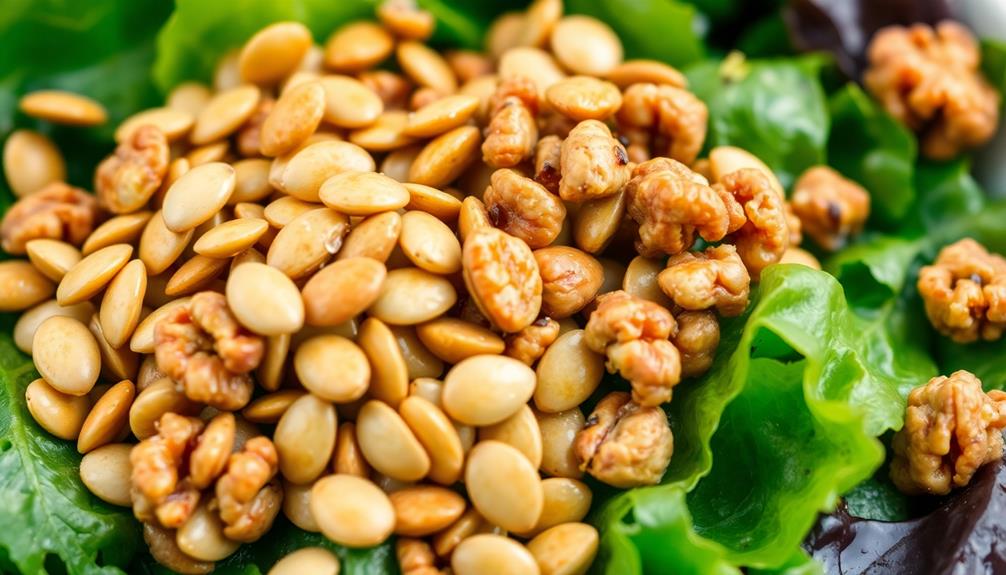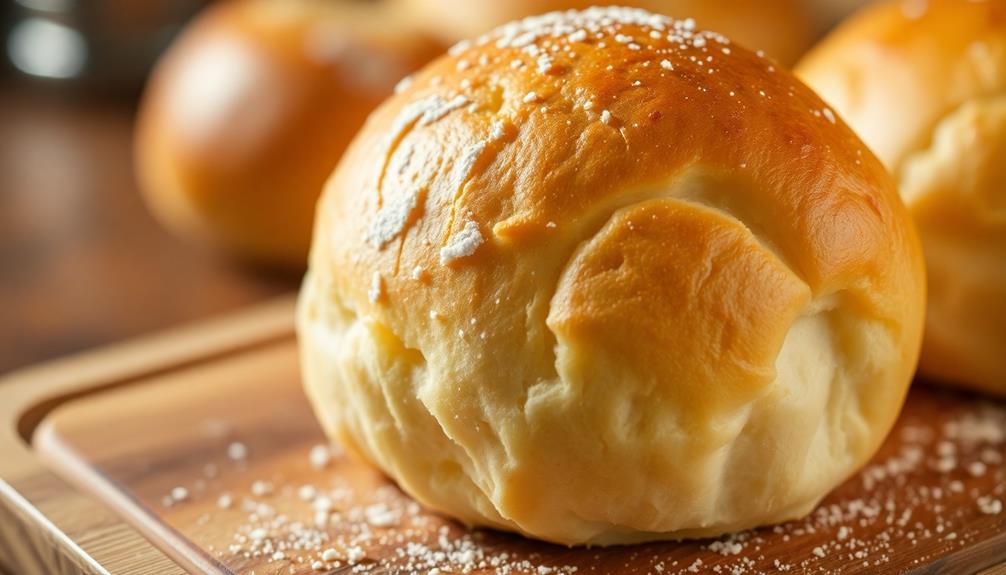A green salad is a timeless dish that has graced tables for centuries. Originating from ancient Mesopotamia and Egypt, this nutritious fare evolved into the elaborate presentations favored by European aristocracy during the Renaissance before becoming a staple in Western households and restaurants. To create your own green salad, start with a mix of crunchy greens like spinach, arugula, and romaine. Add colorful veggies like cherry tomatoes, cucumber, and red onion. Top it off with creamy avocado, crunchy croutons, and toasted nuts. Dress the salad just before serving to maintain freshness, then enjoy this wholesome and flavorful dish. There's more to discover about the history and preparation of green salads.
Key Takeaways
- Green salads consist of a variety of mixed greens, such as spinach, arugula, and romaine lettuce, for diverse textures and flavors.
- Common vegetable add-ins include cherry tomatoes, cucumbers, and red onions, which provide crunch, freshness, and sharp flavor.
- Proper preparation techniques, such as thoroughly washing and drying greens, tossing with dressing, and garnishing with croutons or toasted nuts, enhance the overall salad experience.
- Homemade dressings allow for control over ingredients and the balance of acidity and oil, which is crucial for flavor.
- Enjoying a fresh, colorful salad not only provides essential vitamins and minerals but also contributes to emotional well-being and appreciation for wholesome ingredients.
History
Salads have been a part of human culinary history for centuries. From ancient Mesopotamia and Egypt to classical Greece and Rome, early civilizations embraced the humble green salad as a way to incorporate fresh, nutritious produce into their diets.
The Romans, in particular, were renowned for their elaborate salad creations, featuring a variety of leafy greens, vegetables, herbs, and even fruits.
As the centuries passed, salads evolved, reflecting regional ingredients and cultural influences. In the Middle Ages, European monasteries cultivated elaborate gardens to grow a wide array of salad greens.
During the Renaissance, the Italian courts showcased their culinary sophistication with ornate salad presentations. By the 18th and 19th centuries, the green salad had become a staple in households and restaurants across the Western world.
Today, the green salad remains a versatile and beloved dish, offering a healthy and flavorful way to enjoy the bounty of the garden.
Recipe
A green salad is a simple yet versatile dish that can be enjoyed as a side or a main course. It's a great way to incorporate a variety of fresh, nutrient-dense ingredients into your diet.
To create a delicious green salad, it's important to start with high-quality, fresh ingredients. The combination of crisp greens, juicy vegetables, and a flavorful dressing can elevate a simple salad to new heights.
Ingredients:
- Mixed greens (such as spinach, arugula, and romaine lettuce)
- Cherry tomatoes, halved
- Cucumber, sliced
- Red onion, thinly sliced
- Avocado, diced
- Carrots, grated or julienned
- Toasted sunflower seeds or chopped nuts (optional)
Instructions:
In a large salad bowl, combine the mixed greens, cherry tomatoes, cucumber, red onion, avocado, and carrots. Drizzle your desired dressing over the salad, and toss gently to coat the ingredients evenly.
Sprinkle the toasted sunflower seeds or chopped nuts on top, if using.
Tips:
For best results, use a variety of greens to add different textures and flavors to the salad. Experiment with your favorite vegetables and toppings to create a unique and satisfying green salad.
Remember to dress the salad just before serving to ensure the greens stay crisp and the flavors are at their peak.
Cooking Steps
First, you'll want to make sure to wash and thoroughly dry your greens.
For a refreshing twist, consider adding some seasonal ingredients like roasted pumpkin or nuts, inspired by seasonal elements that enhance flavor and texture.
Once they're prepped, toss the greens with your desired dressing.
Feel free to add some crunchy croutons for texture, and don't forget to garnish with toasted nuts for a delightful finishing touch.
For best flavor, serve the salad immediately.
Step 1. Wash and Dry Greens Thoroughly

Before assembling the salad, you'll want to thoroughly wash and dry the greens. This step is crucial for ensuring your salad is crisp, fresh, and free from any dirt or debris.
Begin by rinsing the greens under cool, running water. Gently swish the leaves around to dislodge any hidden particles. If you're using a delicate green like spinach or arugula, be extra careful to avoid bruising the leaves.
Once rinsed, transfer the greens to a salad spinner. Spin them until completely dry, removing as much moisture as possible. This will prevent your salad from becoming watery or soggy.
If you don't have a salad spinner, you can also pat the greens dry with paper towels or a clean kitchen towel. Make sure to get in between the leaves and remove any lingering dampness.
Step 2. Toss Greens With Dressing

With the greens now washed and dried, you're ready to toss them with the dressing. This is a crucial step in assembling your salad, as the dressing helps to coat and flavor the leaves evenly.
Start by placing the greens in a large salad bowl. Drizzle the dressing of your choice over the top – aim for about 2-3 tablespoons per serving, adjusting based on your personal preferences.
Using clean hands or salad tongs, gently toss the greens and dressing together until every leaf is lightly coated.
Be sure to toss the salad gently to avoid bruising the delicate leaves. Tossing too vigorously can cause the greens to tear and wilt prematurely. The goal is to achieve an even distribution of the dressing without compromising the texture and integrity of the salad.
Once the greens are dressed to your liking, you're ready to serve and enjoy your fresh, flavorful green salad!
Step 3. Add Croutons if Desired

After tossing the greens with the dressing, you can optionally add croutons to your salad for a bit of crunch and texture.
Croutons are small, crunchy cubes of toasted or fried bread that add a delightful contrast to the soft, leafy greens. Incorporating croutons into your salad can elevate the overall eating experience, much like how AI-driven solutions enhance various industries by adding innovative functionalities.
When choosing croutons, you can select from a variety of flavors, such as garlic, herb, or plain.
Consider the overall flavor profile of your salad and choose croutons that will complement the other ingredients. For example, garlic croutons may pair well with a Caesar-style salad, while herb-seasoned croutons could enhance a more Mediterranean-inspired green salad.
To add the croutons, simply sprinkle them over the top of the dressed greens.
You can add as much or as little as you like, depending on your personal preference. The croutons will provide a satisfying crunch in each bite, making your salad even more enjoyable.
Step 4. Garnish With Toasted Nuts

Toasting nuts adds a delightful crunch and depth of flavor to your salad. This simple step elevates the dish, transforming plain greens into a gourmet experience.
To toast your nuts, preheat your oven to 350°F (175°C). Spread the nuts in a single layer on a baking sheet and place them in the oven. Keep a close eye on them, as nuts can burn quickly.
After 5-7 minutes, or until they're lightly golden and fragrant, remove the nuts from the oven. Allow them to cool slightly, then chop or leave them whole, depending on your preference.
Sprinkle the toasted nuts over your salad just before serving. The warm, nutty aroma and satisfying texture will elevate your green salad to new heights.
Experiment with different nuts, such as walnuts, pecans, or almonds, to find your favorite flavor combination.
Step 5. Serve Immediately for Best Flavor

Once you've toasted the nuts, it's time to assemble your salad. For the best flavor, you'll want to serve it immediately. This ensures the greens are crisp, the dressing is fresh, and the toasted nuts retain their perfect crunch.
You can elevate your salad by incorporating a variety of textures and flavors, similar to how a traditional Tuscan seafood stew highlights the richness of ingredients.
First, give your salad greens a gentle toss to distribute any dressing that may have settled to the bottom of the bowl. Then, top with the toasted nuts. The heat from the nuts will help meld the flavors, creating a harmonious balance.
Next, consider any other toppings you'd like to add, such as sliced vegetables, crumbled cheese, or fresh herbs. These can be scattered over the top, allowing the salad's vibrant colors to shine. For a pop of sweetness and color, consider adding a sweet glazed carrots recipe as a topping. This can be a delicious and unexpected addition to your salad, adding a contrast of flavors and textures. The caramelized glaze will add a touch of indulgence to the dish, making it a delightful and satisfying meal.
Final Thoughts
Why not take a moment to reflect on the journey of crafting the perfect green salad? From selecting the freshest greens to perfectly balancing the flavors, you've honed your skills and created a delightful dish.
As you look back, feel proud of the progress you've made. Mastering the art of green salad preparation takes time and practice, but the end result is so worth it. With each salad you make, you'll continue to refine your techniques, discovering new flavor combinations and presentation ideas.
Remember, the beauty of a green salad lies in its simplicity. Focus on using high-quality, in-season ingredients, and let their natural flavors shine.
Experiment with different greens, add-ins, and dressings to find your signature style.
Most importantly, savor the process and the final product. A well-crafted green salad isn't just a meal, but a celebration of fresh, wholesome ingredients. Enjoy every bite, and feel nourished both physically and emotionally.
Frequently Asked Questions
How Long Can a Green Salad Be Stored?
A green salad can typically be stored in the refrigerator for 3-5 days. However, its freshness and crispness will start to decline after the first day or two. Be sure to store it properly in an airtight container.
Can a Green Salad Be Made in Advance?
Yes, you can make a green salad in advance. Just wait to dress it until right before serving to prevent the greens from getting soggy. Store the undressed salad in an airtight container in the fridge for up to 3 days.
What Are the Best Greens for a Green Salad?
The best greens for a salad depend on your personal preferences, but some popular options include spinach, kale, arugula, mixed greens, romaine lettuce, and spring mix. Choose the ones you enjoy most for a delicious and nutritious salad.
How Can I Make a Green Salad More Filling?
To make your salad more filling, add protein-rich ingredients like grilled chicken, hard-boiled eggs, or roasted chickpeas. You can also include complex carbs like quinoa or brown rice, and healthy fats from avocado or nuts.
Can a Green Salad Be Frozen for Later Use?
Can a green salad be frozen for later use? While it's possible to freeze some salad ingredients, freezing the entire salad isn't recommended. The texture and flavor will likely suffer, and the greens may become limp and watery when thawed.










